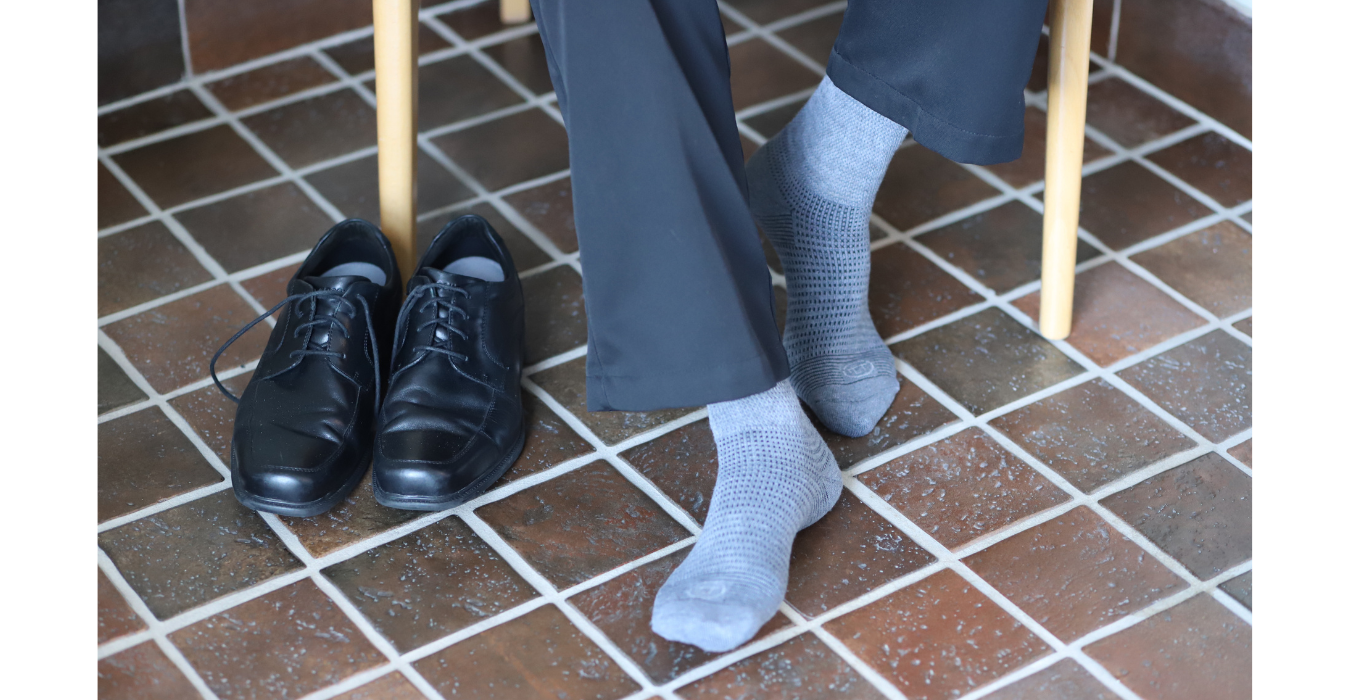When it comes to foot health, wearing the right socks can make a significant difference in your everyday life. Foot care and wearing the right socks is especially important for individuals with diabetes and/or neuropathy, those suffering from varicose veins or those who sit or stand for long periods of time. Two types of socks commonly recommended for these conditions are diabetic socks and compression socks. While they may appear similar at first glance, there are important distinctions between the two. This article will help to shed light on the key differences and guide you in choosing the best socks for your specific needs.
Understanding Diabetic Socks
What are Diabetic Socks?
Diabetic socks are specifically designed to promote foot health and provide additional comfort for individuals with diabetes. They are crafted using seamless construction techniques, have a non-binding top, and feature extra padding in sensitive areas to minimize the risk of blisters and injuries.
Features of Diabetic Socks
Diabetic socks often have a loose, non-restrictive fit to improve blood circulation and prevent constriction. They are usually made from moisture-wicking and breathable materials to keep feet dry, reducing the risk of fungal infections. Additionally, they are seamless to prevent irritation and have a cushioned sole for shock absorption.
Benefits of Diabetic Socks
The key benefits of diabetic socks include reducing pressure points, promoting proper blood flow, minimizing moisture build-up, preventing blisters and ulcers, and enhancing overall comfort. These socks play a vital role in diabetic foot care by minimizing the risk of complications.
Choosing the Best Diabetic Socks
When selecting diabetic socks, consider factors such as proper fit, moisture-wicking properties, cushioning, and the absence of irritating seams. Look for reputable brands that meet the specific needs of individuals with diabetes.
Recommended products
Doctor’s Choice offers many different styles of socks to help you get back to your everyday life. We believe that when your feet hurt, everything hurts. We’ve developed a line of diabetic socks, complete with 8 different styles and offered in many colors, so that you can choose the perfect style and color for you.
For the active diabetic: The Diabetic Half Cushion No-Show Sock

Our best-selling diabetic sock: The Diabetic Crew Sock

For spring & summer shoes: The Diabetic Sneaker Liner Sock

Exploring Compression Socks
What are Compression Socks?
Compression socks are designed to exert graduated pressure on the legs, ankles, and feet. They help improve blood circulation, reduce swelling, and alleviate symptoms associated with various conditions such as varicose veins, deep vein thrombosis (DVT), and edema. They are also great for athletes who are looking for a sock that provides support during a workout and recovery after.
Features of Compression Socks
Compression socks are made from elastic materials that provide pressure to the legs. They are tighter around the ankles and gradually loosen towards the knees. The level of compression is measured in millimeters of mercury (mmHg), and different compression levels are available to accommodate varying needs.
Benefits of Compression Socks
The benefits of compression socks include improved blood circulation, reduced swelling, prevention of blood clots, decreased leg fatigue, and relief from pain and discomfort. They are commonly recommended for individuals who stand or sit for extended periods, pregnant women, athletes, and those with venous or lymphatic disorders. Always consult your doctor before buying and wearing compression socks.
Choosing the Best Compression Socks
When selecting compression socks, consider factors such as compression level, shoe size, calf size, material, and intended use.
For lounging: The Cozy Compression Sock

Our best-selling over the calf sock: The Over-the-Calf Compression Sock

For an active lifestyle: The Compression No-Show Sock

Diabetic Socks vs. Compression Socks
Targeted Conditions
Diabetic socks primarily focus on providing comfort, reducing friction, and preventing foot injuries, while compression socks are primarily used to improve circulation and manage conditions like varicose veins, DVT, and edema. Compression socks have also been shown to improve athletic performance by enhancing muscle efficiency and reducing muscle oscillation during physical activities. By reducing muscle vibration, athletes experience less muscle fatigue, allowing them to perform at a higher level for an extended period. Moreover, the improved circulation provided by compression socks ensures muscles receive an adequate oxygen supply, further boosting endurance.
Design and Material Differences
Diabetic socks typically have a looser fit, seamless design, and extra cushioning, while compression socks have a tighter fit and are made from elastic materials that provide graduated pressure.
Level of Compression
Diabetic socks do not exert compression. Compression socks, on the other hand, are available in different levels of pressure, ranging from mild (8-15 mmHg) to extra firm (over 30 mmHg). The different levels of compression serve unique purposes, so always consult your healthcare professional to determine the appropriate compression level for your specific condition or needs.
Prescription Requirements
Diabetic socks are available over-the-counter and do not require a prescription. Compression socks, particularly those with higher compression levels, may require a prescription depending on the specific medical condition.
Choosing the Right Socks for Your Needs
To make an informed choice, it is important to consult with a healthcare professional who can provide guidance based on your specific condition and needs. They can recommend whether diabetic socks, compression socks, or a combination of both would be most suitable for you.
Choosing the best socks for you: Diabetic vs Compression
Features to Consider
When purchasing diabetic socks, there are several important features and benefits to consider. Here are the most crucial ones:
- Seamless Construction: Diabetic socks should have a seamless design to prevent friction and reduce the risk of blisters and ulcers. This feature ensures optimal comfort and protects sensitive feet.
- Non-Binding Top: Look for socks with a non-binding top that gently conforms to the leg without constricting circulation. This feature helps to prevent restriction and pressure points, enhancing comfort and reducing the risk of complications.
- Moisture-Wicking Properties: Diabetic socks should be made from moisture-wicking materials that draw moisture away from the skin, keeping feet dry and reducing the likelihood of fungal infections. Breathability is essential for maintaining foot health.
- Cushioned Sole: Look for socks with a cushioned sole to provide extra support and shock absorption. This feature helps to reduce pressure on sensitive areas and enhances overall comfort during walking or other activities.
- Proper Fit: Ensuring a proper fit is crucial for diabetic socks. They should be neither too loose nor too tight. Proper sizing helps to prevent wrinkles, bunching, and sliding, reducing the risk of friction and irritation.
- Antibacterial/Antimicrobial Properties: Some diabetic socks incorporate antibacterial or antimicrobial properties, which can help prevent bacterial and fungal growth, further enhancing foot hygiene and reducing the risk of infections.
- Breathable and Lightweight Material: Opt for socks made from breathable and lightweight materials to promote ventilation and prevent overheating. This feature improves overall comfort and reduces moisture build-up.
Benefits of choosing high-quality diabetic socks include:
- Enhanced Foot Protection: Diabetic socks provide additional cushioning and protection against pressure points, reducing the risk of blisters, ulcers, and other foot complications.
- Improved Circulation: The non-binding and seamless design of diabetic socks promotes healthy blood circulation, reducing the risk of circulation-related issues.
- Moisture Management: By keeping feet dry and minimizing moisture build-up, diabetic socks help prevent fungal infections and skin irritations.
- Comfort and Support: Diabetic socks are designed to prioritize comfort and support, allowing individuals to go about their daily activities with reduced foot pain and discomfort.
Remember to consult with a healthcare professional to ensure the best choice of diabetic socks based on individual needs and medical condition.
Diabetic Quarter-Length Sock 6-Pack

When purchasing compression socks, it's essential to consider the following key features and benefits:
- Compression Level: Compression socks are available in different compression levels, ranging from mild (8-15 mmHg) to extra firm (over 30 mmHg). The compression level should be selected based on the specific needs and recommendations of a healthcare professional.
-
Proper Fit: Compression socks should fit snugly but not be excessively tight. They should provide a graduated compression, meaning they are tighter around the ankles and gradually loosen towards the knees. It's important to choose the right size to ensure optimal effectiveness and comfort.

- Graduated Compression: The socks should provide graduated compression, meaning they exert the highest pressure at the ankles and gradually decrease as they move up the leg. This design helps promote healthy blood flow, reduce swelling, and prevent the pooling of blood.
- Material: Look for compression socks made from high-quality, breathable, and moisture-wicking materials. Such materials help keep the feet dry, prevent overheating, and reduce the risk of skin irritations.
-
Durability: Choose compression socks that are durable and can withstand regular use and washing without losing their compression properties. High-quality materials and construction contribute to the longevity of the socks.
Benefits of choosing high-quality compression socks include:
- Improved Circulation: Compression socks promote healthy blood circulation by applying gentle pressure on the legs, aiding in the prevention of blood clots, reducing swelling, and alleviating symptoms associated with venous disorders.
- Reduced Leg Fatigue: Compression socks help alleviate leg fatigue and heaviness, making them beneficial for individuals who spend long hours standing or sitting, such as healthcare workers, travelers, and office professionals.
- Enhanced Performance and Recovery: Athletes often wear compression socks to improve performance, reduce muscle soreness, and aid in post-exercise recovery by increasing oxygen and nutrient delivery to the muscles.
- Prevention of Varicose Veins: Compression socks can help prevent the development or progression of varicose veins by improving venous return and reducing vein dilation.
- Support for Pregnancy-Related Discomfort: Pregnant women may benefit from compression socks, as they can help alleviate swelling, leg cramps, and the discomfort associated with pregnancy-induced circulatory changes.
Remember to consult with a healthcare professional to determine the appropriate compression level and type of compression socks based on your specific needs and medical condition.
Compression Over-the-Calf Sock 3-Pack

Recommended Brands and Products
Doctor's Choice diabetic and compression socks are widely regarded as the best choice for individuals seeking optimal foot health and comfort. These socks are meticulously crafted with the specific needs of individuals with diabetes and those requiring compression therapy in mind. Doctor's Choice socks offer a seamless design to prevent irritation and friction, reducing the risk of blisters and ulcers. They feature a non-binding top that ensures a comfortable fit without constricting circulation. Additionally, Doctor's Choice socks utilize moisture-wicking materials to keep feet dry and promote breathability, essential for preventing fungal infections. These socks are also available in various compression levels, allowing individuals to find the ideal pressure for their condition. With a focus on quality, functionality, and customer satisfaction, Doctor's Choice diabetic and compression socks provide the utmost support and comfort for those seeking the best solution for their foot health needs.Conclusion
In summary, diabetic socks and compression socks serve distinctly different purposes. Diabetic socks focus on providing comfort and reducing the risk of foot complications for individuals with diabetes, while compression socks primarily target improving circulation and managing conditions like varicose veins. Consulting a healthcare professional is essential for selecting the most appropriate socks based on individual needs. By wearing the right socks, you can prioritize foot health and enhance overall well-being.




